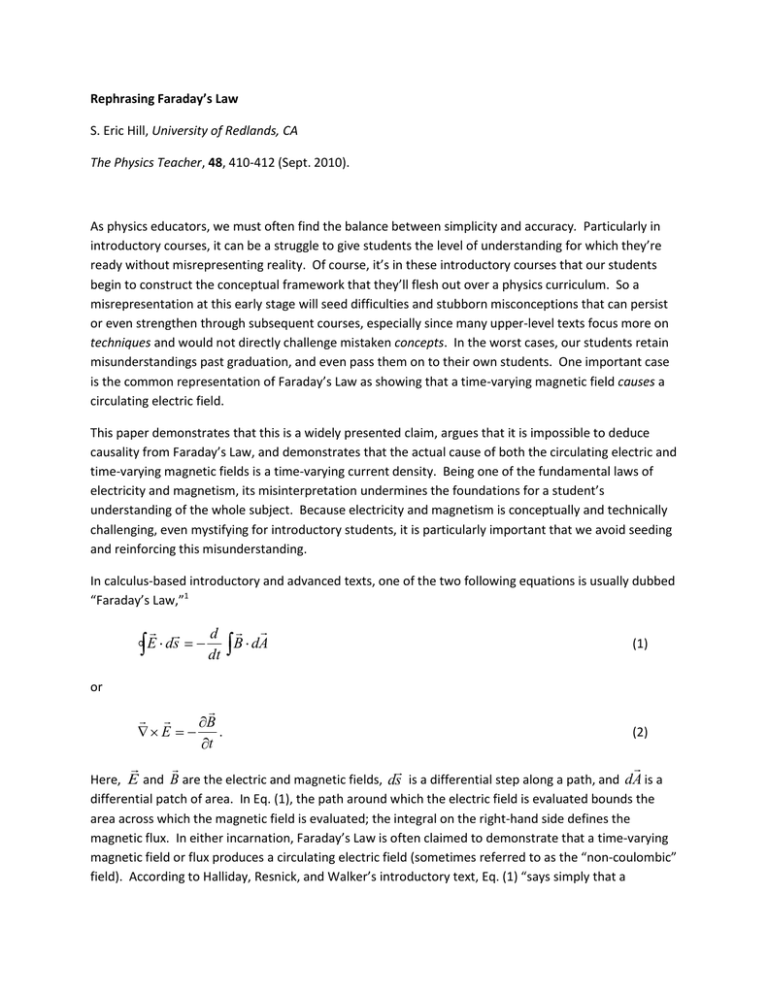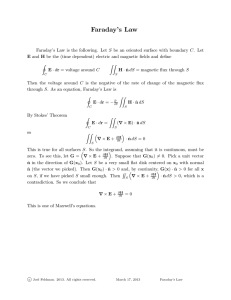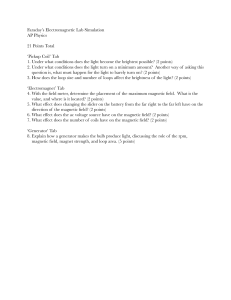
Rephrasing Faraday’s Law
S. Eric Hill, University of Redlands, CA
The Physics Teacher, 48, 410-412 (Sept. 2010).
As physics educators, we must often find the balance between simplicity and accuracy. Particularly in
introductory courses, it can be a struggle to give students the level of understanding for which they’re
ready without misrepresenting reality. Of course, it’s in these introductory courses that our students
begin to construct the conceptual framework that they’ll flesh out over a physics curriculum. So a
misrepresentation at this early stage will seed difficulties and stubborn misconceptions that can persist
or even strengthen through subsequent courses, especially since many upper-level texts focus more on
techniques and would not directly challenge mistaken concepts. In the worst cases, our students retain
misunderstandings past graduation, and even pass them on to their own students. One important case
is the common representation of Faraday’s Law as showing that a time-varying magnetic field causes a
circulating electric field.
This paper demonstrates that this is a widely presented claim, argues that it is impossible to deduce
causality from Faraday’s Law, and demonstrates that the actual cause of both the circulating electric and
time-varying magnetic fields is a time-varying current density. Being one of the fundamental laws of
electricity and magnetism, its misinterpretation undermines the foundations for a student’s
understanding of the whole subject. Because electricity and magnetism is conceptually and technically
challenging, even mystifying for introductory students, it is particularly important that we avoid seeding
and reinforcing this misunderstanding.
In calculus-based introductory and advanced texts, one of the two following equations is usually dubbed
“Faraday’s Law,”1
E ds
d
B dA
dt
(1)
B
.
t
(2)
or
E
Here, E and B are the electric and magnetic fields, ds is a differential step along a path, and dA is a
differential patch of area. In Eq. (1), the path around which the electric field is evaluated bounds the
area across which the magnetic field is evaluated; the integral on the right-hand side defines the
magnetic flux. In either incarnation, Faraday’s Law is often claimed to demonstrate that a time-varying
magnetic field or flux produces a circulating electric field (sometimes referred to as the “non-coulombic”
field). According to Halliday, Resnick, and Walker’s introductory text, Eq. (1) “says simply that a
changing magnetic field induces an electric field.” It continues with “Induced electric fields are
produced not by static charges but by a changing magnetic flux.”2 Young and Freedman’s text
acknowledges that “this may be a little jarring; we are accustomed to thinking about electric fields as
being caused by electric charges, and now we are saying that a changing magnetic field somehow acts as
a source of electric field.”3 Similar statements are found in many of the texts that share or have shared
the introductory physics market over the years.4 A few texts say that the electric field is “associated
with”5 or “accompanied by,”6 rather than “produced by,” the changing magnetic field; however, without
actually indicating what does cause the electric field, these texts allow students to reach the same
conclusion – that the time varying magnetic field produces the electric field.
Unfortunately, such a conclusion would be supported as students moved on to intermediate and even
advanced texts. Purcell’s intermediate-level text replaces “produces” with “determines,” but the subtle
difference is likely lost on students.7 The advanced undergraduate text by Griffith’s does not offer an
interpretation of its own, but it does offer Faraday’s: “Faraday had an ingenious inspiration: A Changing
magnetic field induces an electric field. It is this ‘induced’ electric field that …”8 Jackson’s revered and
feared graduate-level text does the same.9 Regardless of whether these statements are correct, they
would reinforce a student’s misunderstanding that was seeded by an introductory text.
Proof that this misunderstanding remains with a significant fraction of physics students beyond
graduation and even graduate studies is the fact that it appears in generations of introductory texts and
journal articles (the authors of which were once students themselves.) For example, a recent American
Journal of Physics article began its abstract with “Electromagnetic radiation exists because changing
magnetic fields induce changing electric fields and vice versa.”10 Lest the intended meaning of
“induced” be unclear, the article goes on to talk of the “magnetic field produced by the induced electric
field.” It is surprising, given the wealth of literature that addresses difficulties in applying Faraday’s
Law,11 that this author has found few sources that address this difficulty in understanding it.12
While the correlations presented in Faraday’s law and the Ampere-Maxwell law do allow us to deduce
that a changing magnetic field is accompanied by a changing electric field, it is not necessary to claim
that one “induces” or causes the other. In fact, Faraday’s Law cannot be used to establish the oftclaimed causal relationship between the electric and magnetic fields. To establish causality, it is
necessary to establish a time lag between the cause and the effect. In the case of two events at
different locations, the reason is obvious – it takes time for information to travel from one point to
another. Neither representation of Faraday’s Law, Eq. (1) or Eq. (2), incorporates time lags; in fact, Eq.
(2) is explicitly local – it relates the time variation of a magnetic field to the curl of an electric field at the
same point in space. In such a case, the time lag may vanish, but ambiguity replaces it – it is impossible
to use that relationship to establish that the changing magnetic field causes the circulating electric field
(or vice versa.) That is why Jefimenko’s text pointedly says that Faraday’s Law communicates a
“correlation,” 13 and others refer to it as a “kinematic,”14 rather than a dynamic, relationship.
The reason for the perfect correlation between a circulating electric field and a time-varying magnetic
field is that they share a common cause, a time-varying current density. While the proof of this would
not be accessible to introductory students, it should be accessible to instructors. It is simplest if we
begin with the time-dependent generalizations of Coulomb’s Law and the Biot-Savart Law. 15 When
Griffiths presents them in his text, he stresses that they are “the causal solutions to Maxwell’s
equations.”16 They give the electric and magnetic fields as
E (r , t )
4
(r , t r ) J (r , t r )
rˆ d ,
cr
c2r
(r , t r )
rˆ
r2
1
o
(4a)
and
B( r , t )
o
4
J (r , t r )
r2
J (r , t r )
cr
rˆd
(4b)
Here the electric field ( E ) and magnetic field ( B ) are evaluated at location r and time t. They are
found by integrating expressions containing the charge density,
and its time derivative, , as well as
the current density, J , and its time derivative, J , at all locations r throughout the volume of space,
. Since a change in electric and magnetic fields propagates at speed c, it is necessary that the effect
on E (r , t ) and B (r , t ) of a source at point r , which is a distance r
the charges and currents at the previous time, t r
r r away, be dependent on
t r / c . It’s important to note that the current
densities can be taken to include both free and bound currents (such as the atomic-scale “currents” that
are associated with magnetization) and changes in polarization over time;17 thus these relationships are
quite general.18 Plugging the expression for the magnetic field into Equation 2 and taking the time
derivative yields
E (r , t )
t
B( r , t )
o
4
J (r , t r )
r2
J (r , t r )
cr
rˆd
(5)
.
Thus the cause of the curl in the electric field and time variation of the magnetic field is a time-varying
current density.19
Accordingly, introductory texts should offer this revised insight into Faraday’s Law: “This equation says
simply that a changing magnetic field is accompanied by a circulating electric field. (Both are generated
by a time varying current density.)” This statement strikes the appropriate balance between simplicity
and accuracy, and is far less “jarring” to students’ intuition and understanding than is the mistaken
statement that is common found in texts. Strictly speaking, the parenthetical statement has little
bearing on the correct interpretation of Faraday’s law; however, it is necessary to prevent students from
inferring the common incorrect interpretation. This rephrasing should significantly demystify electric
and magnetic fields by relating them back to their physical sources, rather than teaching students (or
just allowing them to assume) that the fields have the unphysical capacity to source each other. We
may hope that, if students of Electricity and Magnetism begin on a firmer foundation, they will have
fewer conceptual and technical difficulties later, and so will their students.
Eric Hill received his B.A. from Carleton College and his Ph.D. from the University of Minnesota. His area
of research is condensed matter.
Department of Physics, University of Redlands, Redlands, CA 92373; Eric_Hill@Redlands.edu
1
These two are not strictly equivalent; for an exact equivalence see G. Monsivais, “The relativistic AmpereMaxwell law in integral form”, Am. J. Phys. 72 (9), 1178-1182 (Sept. 2004).
2
th
D. Halliday, R. Resnick, and J. Walker, Fundamentals of Physics, 6 ed. (Wiley, New York, 2001), p.722.
th
H. Young and R. Freedman, Sears and Zemansky’s University Physics: with Modern Physics, 12 ed. (Pearson
Addison-Wesley, San Francisco, 2007), p 1009.
3
4
th
D. Giancoli, Physics for Scientists & Engineers with Modern Physics, 4 ed. (Pearson Prentice Hall, Upper Saddle
River, New Jersey, 2008), p. 773; D. Halliday and R. Resnick, Fundamentals of Physics, (Wiley, New York, 1970), p.
nd
584; R. Knight, Physics for Scientists and Engineers: a Strategic Approach, 2 ed. (Pearson Addison-Wesley, San
nd
Fransico, 2008), p. 1059; H. Ohanian, Physics, 2 ed. (Norton, New York, 1989) p. 792.;R. Serway and J. Jewett Jr.,
th
Physics for Scientists and Engineers, 6 ed. (Brooks/Cole – Thomas Learning, Belmont, CA, 2004), p. 981; R.
rd
Wolfson and J. Pasachoff, Physics for Scientists and Engineers, 3 ed. (Addison-Wesley, San Fransico, 1999), p. 820.
5
P. Tipler, G. Mosca, Physics for Scientists and Engineers, 5 ed. (Freeman, New York, 2004), p. 900.
th
6
E. Hecht, Physics: Calculus, 2 ed. (Brooks/Cole, Pacific Grave CA, 2000), p. 817.
nd
7
nd
E. Purcell, Electricity and Magnetism Berkeley Physics Course, Volume 2, 2 ed. (McGraw Hill, New York, 1985), p.
274.
8
D. Griffiths, Introduction to Electrodynamics, 3 ed. (Prentice Hall, Upper Saddle River, New Jersey, 1999), p. 302.
rd
9
J. D. Jackson, Classical Electrodynamics, 2 ed. (Wiley, New York, 1975), p. 210.
nd
10
B. Batell and A. Ferstl, “Electrically induced magnetic fields; a consistent approach”, Am. J. Phys. 71, 925-929
(Sept. 2003).
11
For example, F. Sears, “Faraday’s Law and Ampere’s Law”, Am. J. Phys. 31, 439-443 (June 1963); N. Rosen and D.
Schieber, “Some remarks on Faraday’s Law”, Am. J. Phys. 50, 974-975 (Nov. 1982); F. Munley, “Challenges to
Faraday’s flux rule”, Am. J. Phys. 72, 1478-1483, (Dec. 2004); I Gallili, D. Kaplan, and Y. Lehavi, “Teaching Faraday’s
law of electromagnetic induction in an introductory physics course”, Am. J. Phys. 74, 337-343,(April 2006).
12
J. Roche, “Explaining electromagnetic induction: a critical re-examination,” Phys. Educ. 22, 91-97 (1987); W. G. V.
Rosser, Interpretation of Classical Electromagnetism, (Kluwer Academic Publishers, Dordrecht, The Netherlands,
1996), pp. 124-126.
13
nd
O. Jefimenko, Electricity and Magnetism, 2 ed. (Electret Scientific Company, Star City, WV, 1966), p. 498.
14
D. H. Kobe, “Derivation of Maxwell’s equations from the gauge invariance of classical mechanics”, Am. J. Phys.
48, 348-353 (May 1980).
15
Ref 13, pp. 515-516.
16
D. Griffiths, pp. 427-428. This text is recommended for a clear derivation of Eqs. (4).
17
D. Griffiths and M. Heald, “Time-dependent generalizations of the Biot-Savart and Coulomb laws,” Am. J. Phys.
59, 111-117 (Feb. 1991).
18
O. Jefimenko, “Solution of Maxwell’s equations for electric and magnetic fields in arbitrary media,” Am. J. Phys.
60, 899-902 (Oct. 1992).
19
Alternatively, one can directly take the curl of the Eq. (4a). Since derivatives involving retarded times are not
straightforward, particularly useful are the relations A11, A12, and A13 of J. A. Heras “Can Maxwell’s equations be
obtained from the continuity equation?”, Am. J. Phys. 75, 652-657 (July 2007).






